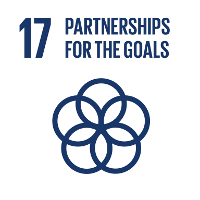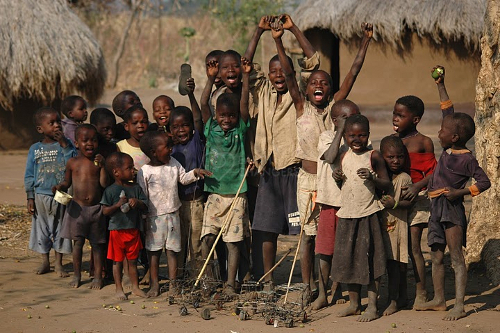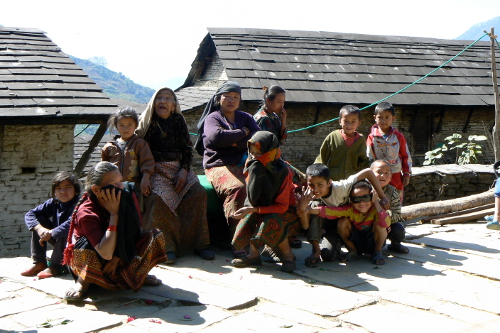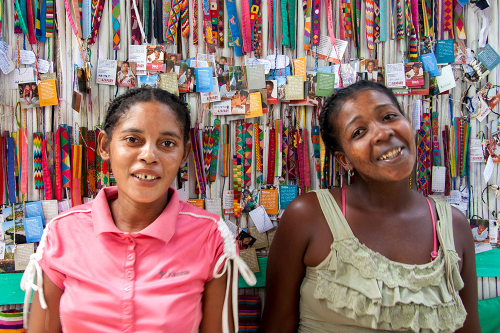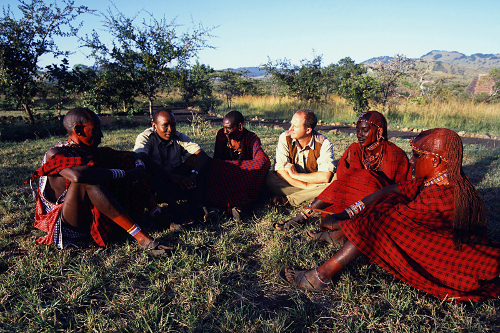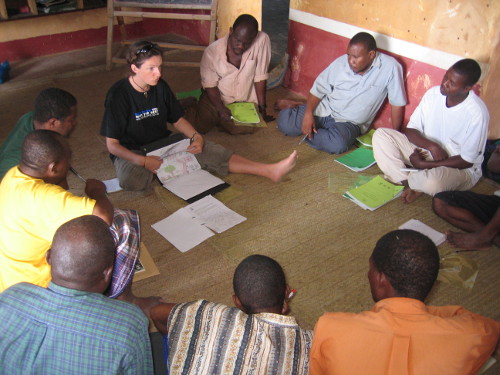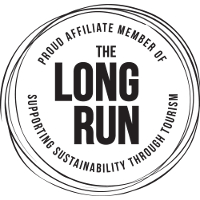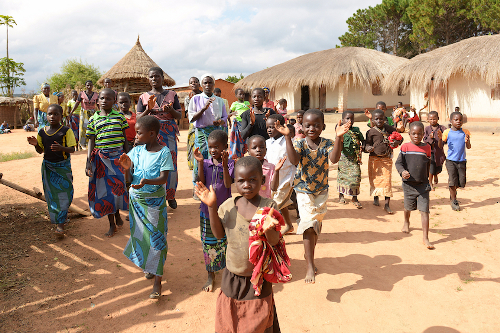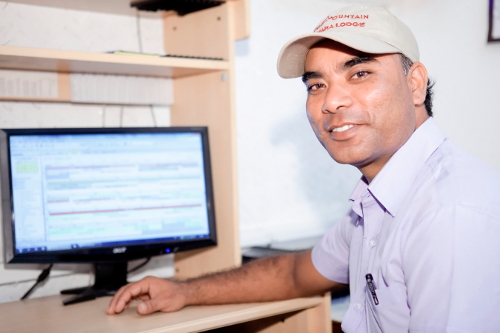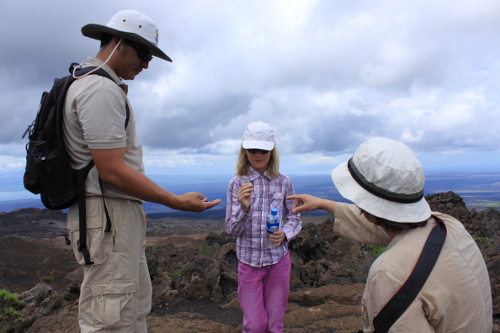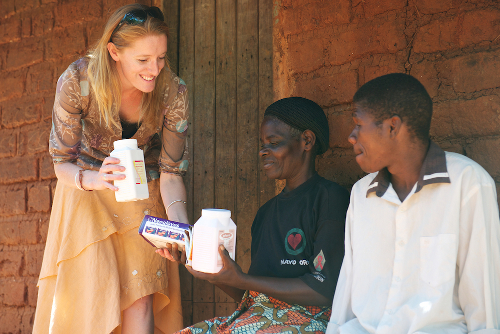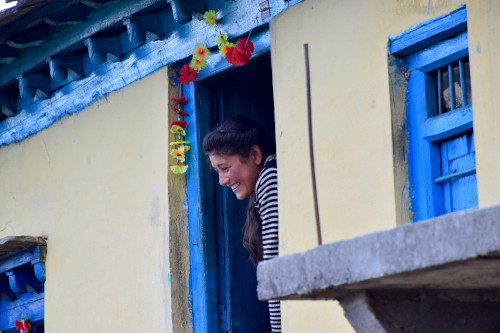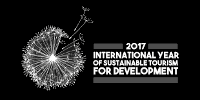The world today is more interconnected than ever before
Tourism, like most products and services, would be impossible without partnerships. Travel agents need technology and systems to sell operators’ products; operators require transport, guides, accommodation, food and beverages; transport requires fuel, guides need knowledge, accommodation requires staff and suppliers, energy and waste disposal; visitors require passports, visas, security…
The wide-ranging cross-sectoral international nature of the travel industry makes it ripe for partnerships across the globe. Behind the scenes, trips include international, national, regional and local stakeholders, with the potential to benefit locals in far corners worldwide.
Sustainable. responsible and regenerative tourism in particular engages in collaboration as a priority, putting the host community first, and working together for social benefits, environmental preservation and great guest experiences.
Creating sustainable development with social, environment and economic net benefits cannot be done alone. The 17 Sustainable Development Goals do not work in isolation – there are strong inter-dependencies, which require cross-sector partnerships to create the strong enabling environments needed for implementation. The goals aim to foster North-South and South-South cooperation and trade.
For this reason, Goal 17 of the UN 17 Global Goals of the 2030 Agenda for Sustainable Development is:
SDG #17 “Strengthen the means of implementation and revitalize the Global Partnership for Sustainable Development”
Progress on Sustainable Development Goal SDG 17 Partnerships for the Goals
$5-7 trillion: the annual cost of achieving the SDGs, according to the UN Conference on Trade and Development.
$18.2 trillion: invested in the ‘sustainable and responsible investments’ asset class, as of 2016.
78%: the increase in investment in global green bonds in 2018 vs 2017, valued at $155.5 billion.
$613 billion: internal remittances (2017), 76% to developing countries; Remittances have exceeded official aid by 3X since mid-1990s.
$147.4 billion: Net Official development assistance (2019, much the same as 2018)
2.6%: increase in aid to Less Developed Countries, yet just 1.3%: increase in aid to Africa (from 2018)
6: the number of countries which met the international target to keep ODA at or above 0.7% of gross national income.
$690 million: international funding for data and statistics, half the level it needs to be.
79% of imports from developing countries enter developed countries duty-free.
3% of export revenue: the debt burden on developing countries.
46.4%: of the world’s population is not connected to the internet, with wide regional range eg. 74% sub-Saharan Africa vs % Europe.
1.1 billion/14.9%: Fixed broadband subscriptions outnumbered fixed telephone connections (931 million); 33.6% / 11.2% for developed and developing countries, respectively, whereas LDCs had almost none due to cost and lack of infrastructure.
The Impact of Covid on SDG 17
Covid threatens and reverses some past achievements on the SDGs, and invigorates necessary engagement in them.
Covid reiterates the need for partnerships. No country can overcome the pandemic alone. Global solidarity is a moral imperative, and is in everyone’s interests: The international community need to deliver an effective, coordinated response to COVID-19, such as through the UN World Health Organisation. Extra funding is required to support developing countries to respond and recover.
-40%: The amount trade, foreign direct investment and remittances are all predicted to fall; and another 5% in 2021.
-20%: Global remittances are projected to fall in 2020 – the steepest decline in recent history, largely due to a fall in the wages and employment of migrant workers, who tend to be more vulnerable in economic crises than non-migrants in host countries.
$445 billion: Remittances to low- and middle-income countries are projected to decline 19.7% from $554 billion (2018), overtaking even foreign direct investment flows.
-13-32%: the drop in global trade expected. Its share of LDC exports was just above 1%, far from its target double (2018),
A global recession and new debt crisis looms, compounded by tumbling prices for oil and other key commodities, heavily impacting Least Developed Countries already at high risk of debt distress. The UN is calling for targeted debt relief and have launched a fund.
Partnerships are required for open and timely access to critical data to respond to the crisis, share guidance, actions, tools and best practices and ensure continuity of data programmes by National Statistical Offices, including combatting Covid19 misinformation.
The UN has set out a Global Humanitarian Response Plan to assist most vulnerable populations, including refugees and internally displaced persons.
Digitally divided: Lockdowns precipitate the increased use of technology and the Internet to work, shop and connect with others.
Challenges of SDG17, Partnerships for the Goals
Policy
From Old French policie ‘civil administration’, via Latin from Greek politeia ‘citizenship’, from politēs ‘citizen’, and from polis ‘city’, forming the basis of ‘politics’ itself, Policy refer to the basic principles by which governments are guided in the interests of nations.
At global policy level, international co-operations between national governments, public institutions and regulatory bodies create such principles to support decision-making, implementation and evaluation, through procedures and protocols.
The Sustainable Development Goals overall are an example, developed by The United Nations, an intergovernmental partnership organization formed after the 2nd World War in 1945 to promote international cooperation and to create and maintain international order.
Main objectives include peace keeping and security, human rights, economic development and humanitarian assistance. Specialised agencies support the work, such as The World Bank Group, the International Labour Organization, the International Monetary Fund, the World Health Organisation and the World Tourism Organisation (who supported Earth Changers as a solution provider for advancing sustainable tourism).
From a sustainable tourism point, many organisations have a responsible tourism policy. But policy does not necessarily mean practice, and ‘greenwashing’ can say all the right things for PR but mislead in claims.
Marcus Cotton from Tiger Mountain Pokhara Lodge makes an important point. Effective achievement is only possible if all stakeholders (staff, guests, suppliers, community, authorities…) are fully informed, aware and take personal responsibility for policy,
"Personal choice and drive through understanding is inherently more sustainable than mechanical implementation of company rules”.
Policy alone cannot realise benefits. Principles require engagement, strong commitment and implementation support from governments, other inter-governmental organisations (some invited ‘observers’ to the UN), academia, non-governmental organisations, businesses and individuals in partnerships in many ways.
Finance
Official Development Assistance
One such inter-governmental organisation is The Organisation for Economic Co-operation and Development (OECD), founded in 1960 by countries committed to democracy and market economy to identify, coordinate and stimulate best practice for economic progress and world trade. Most members are high income economies with a very high Human Development Index. Many make up the Development Assistance Committee (DAC), with others, which contributes to a common foreign aid budget.
Coordinating policies to help developing countries manage their debt, as well as promoting investment for the least developed, is vital to achieve sustainable growth and development.
Many countries require Official Development Assistance to encourage and support growth and trade. While assistance increased 66% from 2000 to 2014, with main beneficiaries in sub-Saharan Africa, Latin America and the Caribbean, humanitarian crises caused by conflict and natural disasters necessitated more financial resources, with less tending to go to the neediest sub-Saharan African countries. As global warming and conflicts increase, more aid may be required, as seen with Covid - many countries had little resource to cope.
Debt finance
Debt service in lower-middle-income countries fell from 12.9 per cent to 3.6 per cent between 2000 and 2011, before rising slowly to 6.1 per cent in 2015. In low-income countries, debt service hit a low of 3.2 per cent in 2010 before increasing in subsequent years, reaching 4.5 per cent in 2015. Covid looks likely to cause another rise.
Key to reduction is enhanced debt management, attractive borrowing conditions and increased export earnings in international markets.
Finance also helps deliver other sustainable development goals. For example,
In Malawi small village financed loans enable female empowerment and greater gender equality, supporting women to set up businesses, of key importance as small and medium-sized enterprises provide two thirds of jobs in developing countries and up to 80% in low income countries, and create further opportunity for self-sustaining wealth generation, innovation and creativity.
SEED Madagascar’s Stitch St Luce project, which trains and empowers women to run an embroidered products international business for sustainable livelihoods, has also seen a beneficial result of women’s income on better family health and education attendance.
Nikoi Island has also helped establish employment opportunities through local businesses such as car hire and alang-alang (ylang ylang) grass roofs, beneficial to the community, operations and guests.
Lapa Rios built and supports the local primary school, to encourage local education, community and employment over rural-urban migration.
Tiger Mountain Pokhara Lodge supports the school and education, as well the community water and health first aid provision.
International remittances
These monies sent by migrants to their home countries are vital financial support, especially with the majority for developing countries. Contribution of remittances to individuals, families, communities and countries income still has a profound impact, exceeding 4% GDP for LDCs in 2015.
Private/public partnerships
With such ambitious goals as the Sustainable Development Goals to implement national plans globally to achieve targets, multiple stakeholders from the private and public sectors can contribute specialisms and support the flow of finance, knowledge and skills to work for common goals and connect policy to grassroots practice, sustainably.
In doing so, they can help developing countries increase exports to achieve a universal, equitable, fair and open international trade system that benefits all.
As public funds are cut, for example from health, education and infrastructure (three of the other SDGs), public/private partnerships have become more commonplace.
RSC’s experience shows that, like many African nations, Malawi has seen a lot Chinese investment in infrastructure like roads and bridges, as well as health and safety. This not only opens doors to tourism but also enables groups like schools to be fully supported.
Tourism organisations focused on delivering positive impacts locally often have foundations to manage the funding and delivery of sustainability initiatives, for example
Nikoi Island in Indonesia has its Island Foundation. In some cases, the tourism becomes an arm of its partnered not-for-profit Non-Governmental Organisation, for example the Maasai Wilderness Conservation Trust NGO has become the larger operation of its Campi ya Kanzi in Kenya tourism arm, and works in partnership with the Government of Kenya and its Ministry of Health, for the 16,000 strong Maasai community.
As an NGO, SEED Madagascar’s stated mission is "To enhance the capacity of individuals, communities, organisations and government in fulfilling sustainable environment, education and development goals in southeast Madagascar", working also with private sector tourism organisations to enable volunteer placements and fundraising.
Such multi-stakeholder private/public partnerships are a core foundation for tourism development: for example, state-supported tourism boards and private tourism businesses share the common goal of marketing destinations, both wanting them to be better places to live in and visit: it makes sense work closely with each other in partnership.
Capacity building
To do jobs competently, creating, improving, and retaining skills and knowledge is needed, for example recruiting into required roles, training and staff retention initiatives.
In 2015, total ODA for capacity-building and national planning was $21 billion: 19% of total aid, as has been the case since 2010. Main recipients of assistance were the public administration, environment and energy sectors, together receiving $8.2 billion.
Systems & processes
In order to achieve strategic objectives, organised procedures help manage, deliver, measure and monitor efficiency and effectiveness.
A national statistical plan is key to strengthening a nation's statistical system to support a strategic development vision.
While between 2010 and 2015 the number of countries with a plan increased, and mostly outnumbered those without, many countries remained without a plan; in Small Island Developing States those without outnumbered those with an active plan 17:7. Only 17 countries, mostly in Europe and Northern America, have fully funded plans.
Countries’ own results frameworks enable results reporting of the SDGs, enhanced by other national monitoring systems. In 2016, 125 countries engaged in monitoring development effectiveness, demonstrating commitment to implementing the Global Goals and multi-stakeholder partnerships; 54 reported overall progress.
Likewise, Tourism Master Plans for destinations help drive decision-making processes, implement policies, promote results-focused management and monitor progress. These must be integrated into a country’ other plans, interlinked as they are with security, infrastructure, investment, transport, heritage, conservation, communities and so on. For example, tourism will be integrated into Coastal Zone Management plans to help conserve and preserve fragile ecosystems. Quite often, different partnership contracts will be agreed to manage different parts of a plan, for example transport operators, accommodation, day tour operators, dive operators etc.
In sustainable tourism, strict sustainable management plans are also required to restore and safeguard populations and balance environments for longevity. This is where accreditation and certification agencies often step in, ideally providing a 3rd party objectively-verified framework and assessment for sustainability.
Earth Changers’ partnership with The Long Run is a great example. The not-for-profit is a global membership organisation of private protected areas, whose high level Global Ecosphere Retreat (GER) standard provides a verified frame of reference for its “4C” sustainability as a balance of Community, Conservation, Culture and Commerce initiatives for net positive impacts.
Likewise, The Long Run partners with other non-profits, such as the Global Sustainable Tourism Council, who ‘recognise’ the GER standard meets its guiding principles and minimum requirements to protect and sustain the world’s natural and cultural resources, and ensure tourism meets its potential as a tool for conservation and poverty alleviation.
Data monitoring
Accountability requires data: there is growing awareness of the importance of statistics for evidence-based policy-making and development.
The Sustainable Development Goals have data requirements, but there is a capacity gap in its funding for implementation.
National statistical plans were being implemented by 81 out of 154 to report on the SDGs in 2016. However, only 37 of 83 countries or areas with pertinent data had national statistical legislation in place that complied with all 10 Fundamental Principles of Official Statistics.
Population and housing census are a key source of data to help formulate, implement and monitor development policies and programmes. From 2007 to 2016, 89% of countries or areas around the world conducted at least one, however 25 countries or areas were without one, for example due to financial constraints, technical difficulties in preparation, natural disasters, and political and social instability. Among these countries or areas, nine were in sub-Saharan Africa and seven were in Northern Africa and Western Asia.
Birth and death registration data is also key to monitoring development and SDG 16, justice. Information on births, deaths and population census is key to producing basic health statistics and indicators. Without this data, sustainable development is challenging.
For sustainable tourism, measuring and data on economic, social and environment impacts is key to aiming for and achieving improvement, as described in SDG12, Responsible Consumption and Production.
Tiger Mountain Pokhara Lodge measure many criteria, such as water use, energy and employment. For conservation, vulture and raptors are monitored for a joint project with another lodge, butterflies for national researchers, Asian Waterfowl for Bird Conservation Nepal and Birdlife International NGOs, and the climate twice a day for the Nepalese government Department of Meteorology. Measuring, monitoring and data evidence to back up work provides a framework to keep the lodge on track and improving.
Technology
Improving equal access to IT and communications tools helps link us, share knowledge, foster innovation and report data and accountability, wherever we are. However, for large numbers of people in developing countries, connection remains unaffordable and unavailable, highlighting a vast digital divide, widened by connection necessity during Covid lockdowns.
Fixed broadband penetration is one measure used; Total population online is another measure. In developed regions, this is about nearly 90% of the total population, about 40% in developing regions and 15% in the Least Developed Countries.
But in total, billions still do not have access to reliable phone services, and/or the internet and there remains a large gender gap in internet user penetration. Societies require this technological infrastructure to support development.
In tourism, technology - increasingly Internet - enables marketing, sales and logistical arrangements for tourists to book trips. In sustainable tourism, it enables alternative energy sources, helps conservation of species (such as anti-poaching drones) and facilitates community initiatives such as in education and health.
Trade
Trade is an important means of implementation for the 2030 Agenda. The targets call for countries to promote a universal, rules-based, open, non-discriminatory and equitable multilateral trading system; the increase of developing countries’ exports and doubling the share of exports of least-developed countries (LDCs); and the implementation of duty-free and quota-free market access for LDCs with transparent and simple rules of origin for exported goods. The World Trade Organisation is the key channel for delivering these goals. Trade may be merchandise (goods) or services.
Tourism, as a service industry, offers a significant opportunity for economic benefits and job creation and exports: International visitor spending amounted to US$1.7 trillion in 2019: 6.8% of total exports, 27.4% of global services exports.
In some countries, tourism can contribute up to 40% to GDP, and is an especially important industry for less developed countries, representing more than aid:
“In 2013, tourists spent $413 billion in developing countries, about three times the amount of official development assistance that year. In 2015, for the first time in history, more people will travel to the developing world than to the developed world - about 550 million people overall.” World Bank Group President, Jim Yong Kim
Tourism can reach far into the extremities of a country, where other industry cannot, enabling business partnerships and development for communities otherwise neglected.
Community-based tourism in particular – tourism in true partnership with the local community in ownership, development and benefits - sees visitors hosted by locals, offering the tourist a deep experiential, participatory, cross-cultural insight into local people, culture and environment.
In The Galapagos, experience its first community-based tourism, on Floreana Island. Historically, tourists may have had great trips to the islands but with little connection with the community and have left none the wiser about the local cultural, social and environmental issues and with little benefit going to support the island's issues and people. This new initiative offers a rare and precious real insight into island life.
In Malawi, RSC facilitates immersive learning opportunities and challenge events to enable incredible insight into key global challenges facing rural communities. It is committed to sustainable development through social enterprise, reducing the dependence on the aid industry and driving tourism-generated income to rural communities through partnership. Global Sustainable Development tourism programmes offer participatory experiences of Malawi’s key trade goods and exports, such as Fair Trade tea, sugar and coffee, with homestay accommodation to experience living within a family learning about the complexities and simple joys of Malawi village living.
In India, the founders of Village Ways created a network of Village Tourism Enterprises (VTE) partnerships with communities.
Their work included structuring and developing tourism committees to help training needs, skills and capacity development and local supply chains, to design and develop a tourism product based around village homestay-like guesthouses, and find a sustainable route to market.
The original founders also remain as partners in the form of an international Advisory Council.
Links with the other Sustainable Development Goals
Tourism has the ability to engage multiple stakeholders – international, national, regional and local – and strengthen private/public partnerships to work together to achieve the SDGs and other common goals due to its cross-sectoral nature:
Goal 1 - End Poverty: Tourism can partner with NGOs to ensure poverty-stricken local people benefit.
Goal 2 - Zero hunger: Tourism’s food supply requirements can support local agricultural producers and ensure no waste with initiatives for staff and community.
Goal 3 - Health & Well Being: Multi-stakeholder partnerships can step in where public funds are not available to support staff and community health initiatives.
Goal 4 - Quality Education: Tourism can help train for livelihoods, and offer financial assistance for local pupils and schools, where public funding is insufficient.
Goal 5 - Gender Equality: Partnerships can supporting women’s empowerment and entrepreneurialism.
Goal 6 - Infrastructure for water and sanitation can be developed for tourism requirements which support local communities access.
Goal 7 – Affordable, reliable, sustainable and modern energy requires investment; in developing countries often from aid in conjunction with public and private sector partnerships.
Goal 8 - Economic growth & productive employment – partnerships help growth, job creation and capacity building through training.
Goal 9 - Infrastructure, sustainable industrialization and innovation – public/private partnerships can deliver projects with social, environmental and economic balanced benefits.
Goal 10 – Equalities can be improved working collaboratively in partnerships.
Goal 11 – Cities and human settlements: Partnerships between city public bodies and private enterprise can support sustainable social and urban issues: migration, housing, energy, waste, environment and quality of life, for ‘better places to live in and visit’.
Goal 12 - Sustainable consumption and production: Transitioning to sustainable economies globally necessitates partnerships with policy setters, public and private sectors and NGOs.
Goal 13 - Climate Change: The world’s biggest issue requires partnerships across the globe in all sectors to act for prevention, mitigation and adaptation.
Goal 14 - Life below Water: Marine ecosystems require policy and practitioners to be sustainably managed.
Goal 15 – Life on Land: Our huge complex ecosystem requires partners for sustainable management and conservation.
Goal 16 – Peace, Justice & Strong Institutions – cannot be achieved alone, only in consensus, with Policy, an enabling environment and the partnerships involved.
< Peace, Justice & Strong Institutions SDG16: Previous
Blog: What are the Sustainable Development Goals and what have the got to do with Tourism?
